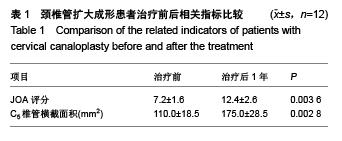| [1] Denis F.The three column spine and its significance in the classification of acute spinal trauma.Spine. 2002;27(3): E64-E70.[2] Hirabayashi K,Watanabe K,Wakano K,et al. Expansive open-door laminoplasty for cervical spinal stenotic myelopathy. Spine. 1983;8(7):693.[3] Yang SC,Yu SW,Tu YK,et al.Open -door laminoplasty with suture anchor fixation for cervical myelopathy in ossification of the posterior longitudinal ligament. J Spinal Disord. 2007; 20(7): 492.[4] Hirabayashi K. Operative procedure and results of expansive open-door laminoplasty. Spine. 1998;13:870.[5] Mesfin A, Park MS, Piyaskulkaew C,et al. Neck Pain following Laminoplasty. Global Spine J. 2015;5(1):17-22. [6] Vinken PJ,Bruyn GW(eds).Handbook of clinical neurology. New York:Elsevier,1975:1.[7] Tredway TL,Santiago P,Hrubes MR,et al. Minimally invasive resection of intradural-extra- medullary spinal neoplasms. Neurosurgery. 2006;58(1 suppl):52-58.[8] Wiedemayer H,Sandalcioglu IE,Aslders M,et al. Reconstruction of the laminar roof with miniplates for a posterior approach in intraspinal surgery :technical considerations and critical evaluation of follow-up results. Spine. 2004;29(16):E333-E342.[9] 章凯,吴增晖,尹庆水,等.棘突椎板回植椎管成形在胸椎后路手术中的应用[J]. 第三军医大学学报,2007,29(6):547-549.[10] Menku A,Koc RK,Oketem IS,et al.Laminoplasty with miniplates for posterior approach in thoracic and lumbar intraspinal surgery .Turk Neurosurg. 2010;20(1):27-32.[11] Hosono N,Yonenobu K, Ono K. Neck and shoulder pain after laminoplasty. Spine. 1996;21(17):1969-1973.[12] Wang MY,Green BA.Open-door cervical expansile laminoplasty. Neurosurg. 2004;54(1):119-124. [13] Edwards CC, Heller JG,Murakami H. Corpectomy versus laminoplasty for multilevel cervical myelopathy: an independent matched-cohort analysis. Spine. 2002;27: 1168-1175. [14] Wada E, Suzuki S, Kanazawa A, et al. Subtotal corpectomy versus laminoplasty for multilevel cervical spondylotic myelopathy: a long-term follow-up study over 10 years. Spine. 2001;26:1443-1448.[15] Chiba K, Toyama Y,Matsumoto M, et al. 1Segmental motor paralysisafter expansive open-door laminoplasty. Spine. 2002; 27:2108-2115.[16] 刘明,王晓,王维,等.单开门颈椎管扩大成形术的早期并发症及其防治[J].中国骨与关节损伤杂志,2005,20(7):496-497.[17] 孙宇.关于轴性症状[J].中国脊柱脊髓杂志,2008,18(4):289.[18] Yoshida M, Tamaki T, Kawakami M, et al. Does reconstruction of posterior ligamentous comp- lex with extensor musculature decrease axial symptoms after cervical laminoplasty. Spine. 2002;27:1414-1418.[19] Satomi K,Ogawa J, Ishii Y, et al. Short-term complications and long-term results of expansive open-door laminoplasty for cervical stenotic myelopathy. Spine J. 2001;1: 26-30. [20] Wang JM,Roh KJ,Kin DJ,et al.Anew method of stabilizing the elevated laminae in open-door laminoplasty:using an anchor system.J Bone Joint Surg(Br). 1998;80(6):1005.[21] Brien MF,Peterson D,Casey AT,et al.A novel technique for laminoplasty augmentation of spinal canal area using titanium miniplate stabilization:a computerized morphometric analysis. Spine. 1996;21(4):474.[22] McGirt MJ,Ambrossi GL,Parker SL,et al. Short-term progressive spinal deformity follow- ing laminoplasty versus laminectomy for resection of intradural spinal tumors:analysis of 238 patients. Neurosurgery. 2010;66(5):1005-1012.[23] Oda I,Abumi K,Cunningham BW,et al.An in vitm human cadaveric study investigating the biomechanical properties of the thoracic spine. Spine. 2002;27(3):E64-70.[24] Cusick JF,Yoganandan N, Pintar F,et al. Thoracic and lumbar laminoplasty using a transl- aminar screw: morphometric study and technique. J Neurosurg Spine. 2009;10(6):603-609.[25] 刘军曙,文建平,向孝勇,等.椎板棘突复合体截取原位回植椎管成形术在椎管内肿瘤手术中的应用[J].医学临床研究2008,25(11): 2048-2050.[26] 刘小波,林爱国,唐宏图,等.棘突椎板回植椎管成形术在椎管内肿瘤手术中的应用[J].中国临床神经外科杂志,2010,15(4): 243-244. |


.jpg)
.jpg)
.jpg)